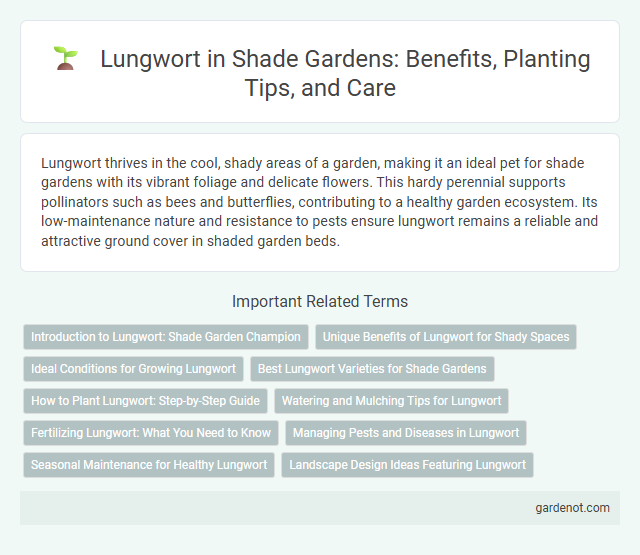Lungwort thrives in the cool, shady areas of a garden, making it an ideal pet for shade gardens with its vibrant foliage and delicate flowers. This hardy perennial supports pollinators such as bees and butterflies, contributing to a healthy garden ecosystem. Its low-maintenance nature and resistance to pests ensure lungwort remains a reliable and attractive ground cover in shaded garden beds.
Introduction to Lungwort: Shade Garden Champion
Lungwort (Pulmonaria) thrives in shaded garden areas, making it an ideal choice for under trees or in woodland settings. Its early spring blooms in shades of blue, pink, and white provide vital nectar for pollinators while the silvery-spotted foliage adds year-round interest. Lungwort's ability to tolerate moist, well-drained soils and resist deer makes it a low-maintenance, durable shade garden champion.
Unique Benefits of Lungwort for Shady Spaces
Lungwort (Pulmonaria) thrives in shady gardens, offering vibrant early spring blooms that attract pollinators such as bees and butterflies. Its broad, spotted leaves provide excellent ground cover, suppressing weeds and retaining soil moisture in low-light conditions. Lungwort's exceptional tolerance to shade and its ability to improve soil health make it an ideal perennial for enhancing biodiversity in shaded garden areas.
Ideal Conditions for Growing Lungwort
Lungwort thrives in shaded or partially shaded areas with well-drained, moist soil rich in organic matter. It prefers cool climates and benefits from protection against harsh afternoon sun to prevent leaf scorch. Consistent watering and mulch help maintain soil moisture, ensuring optimal growth and vibrant foliage.
Best Lungwort Varieties for Shade Gardens
Pulmonaria officinalis, commonly known as Lungwort, thrives in shade gardens with its attractive spotted leaves and early spring blooms. Top varieties for shade gardens include 'Majeste,' noted for its deep blue flowers, 'Benita' with vibrant pink blossoms, and 'Raspberry Splash,' which offers striking variegated foliage. These cultivars provide excellent ground cover and add color to shaded areas, making them ideal choices for shady garden landscapes.
How to Plant Lungwort: Step-by-Step Guide
Plant lungwort in well-drained, moist soil enriched with organic matter, choosing a shaded location to mimic its natural woodland habitat. Space the plants about 12 to 18 inches apart to allow adequate air circulation and prevent fungal diseases. Water consistently to keep the soil evenly moist, and mulch around the base to conserve moisture and suppress weeds.
Watering and Mulching Tips for Lungwort
Lungwort thrives in consistently moist, well-drained soil, requiring regular watering to prevent dryness, especially during hot, dry spells. Applying a 2-3 inch layer of organic mulch, such as shredded leaves or bark, helps retain soil moisture and regulate temperature around the roots. Mulching also suppresses weeds and improves soil fertility, creating optimal conditions for Lungwort's growth in shaded garden areas.
Fertilizing Lungwort: What You Need to Know
Lungwort thrives in shaded gardens with well-drained, humus-rich soil that retains moisture without becoming waterlogged. Fertilizing Lungwort should be done sparingly in early spring using a balanced, slow-release fertilizer high in nitrogen to encourage vibrant foliage and healthy growth. Avoid over-fertilizing to prevent lush greenery at the expense of its characteristic spotted flowers.
Managing Pests and Diseases in Lungwort
Effective management of pests and diseases in Lungwort (Pulmonaria) involves regular inspection for common issues such as powdery mildew, slugs, and aphids. Applying neem oil or insecticidal soap can help control infestations while maintaining plant health. Ensuring proper air circulation and avoiding overhead watering reduce the risk of fungal diseases in shaded garden environments.
Seasonal Maintenance for Healthy Lungwort
Regular pruning of Lungwort in early spring removes old, damaged leaves and encourages fresh growth, enhancing its vibrant foliage. Applying a layer of organic mulch helps retain moisture and regulate soil temperature during dry summer months. Dividing clumps every 3 to 4 years prevents overcrowding and promotes vigorous plant health in shaded garden areas.
Landscape Design Ideas Featuring Lungwort
Lungwort thrives in shaded garden beds, offering vibrant spotted flowers and attractive foliage that enhance under-canopy landscapes. Integrate Lungwort alongside ferns and hostas to create textural contrasts and seasonal interest in moist, well-drained soil. Its early spring blooms attract pollinators, making it an excellent choice for naturalistic woodland garden designs.
Lungwort Infographic

 gardenot.com
gardenot.com